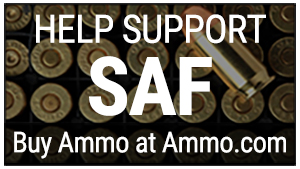
By Mike Nesbitt | Contributing Editor
The .38-55 is certainly a noteworthy caliber or cartridge. Its reputation as a target cartridge is quite well known and, of course, that reputation was established with black powder.
Likewise, the Winchester Highwall, and the more recent copies of that gun such as my new one from C. Sharps Arms also has a grand reputation. My new Highwall in .38-55 has a shotgun butt, which “transfers” recoil the softest, along with a pistol grip which is a great aid for offhand shooting. The combination of this new rifle and the .38-55 cartridge, with its single-set trigger, makes a great base for some excellent shooting.
What I wanted when this gun was ordered, was a rifle that would be used in short-range shooting but might also be useful in mid-range shooting which extends the target distance out to 600 yards. While I’ve shot this new rifle rather limitedly so far, I can report that it is treating me rather well. Its recoil is certainly on the light side when using full black powder loads and I can shoot it with welcome comfort, with no shoulder pad or other protection. I’m still looking for the magic black powder and cast bullet load that both the rifle and I will like. Yes, searching for that magic load is just part of the fun and I’m really enjoying the time spent getting to know this rifle.

The gun that is mainly involved with this story is the .38-55 Highwall which I told you about in the story called “My Old Man’s Gun,” (July 19, 2024) called that because it’s a rifle I should be very comfortable with when I suddenly become an old man. (That might happen this year!) This rifle is on the heavy side, with the #5 barrel (which copies the heaviest barrel Winchester would put on a Highwall except for very special orders) and it has a very light recoil. Heavy recoil, such as from a heavily loaded black powder Sharps in one of the old “buffalo calibers,” was something I wanted to stay away from.

And because I am mostly interested in short-range shooting, why not do that with a duplication of the old black powder .38-55 Short Range load? That could be easier to do than it sounds. For years Lyman had their mold for the copy of the .38-55 Short Range load available and I have had one for years. The number on my mold is #37583 and after the years following computerization, where all bullet molds had to have a six-digit number, it might have been listed as 375083. That mold drops a two-groove b bullet weighing just 155 grains.
Lyman dropped that bullet some years ago but I was able to find used versions of it on eBay, enough of them that I could pick and choose before buying. If a new bullet mold is desired, let me recommend Accurate Molds’ #38-155B, a bullet with the same weight and a very similar general shape when compared to Lyman’s #37583. One difference between the two bullets is that the Accurate bullet has only one lube groove, but that’s a large lube groove which will probably hold more lube than the two grooves on the old Lyman design. Bullets from Accurate’s molds have always worked very well for me and I certainly do recommend them. I might go ahead and get one of the molds from Accurate for #38-155B just to have it on hand.
(Likewise, if a short-range load for the .32-40 is desired, try Accurate Molds’ #32-096S for a bullet. That loaded over 13 grains of black powder, and I’d probably use Olde Eynsford 2F again, will duplicate the old short-range loading.)
For at least a short while, Lyman advertised the bullets from their .38-55 Short Range molds as being a good conical slug for the .36 Navy percussion revolvers. It is a bit heavier than the typical 130-grain conical used in the old Colt Navy Model but I guess it would work, perhaps with a reduction in the powder charge so it could be seated deeply enough. Any further comments I might have about using bullets from #37583 in a revolver would be simply guess-work because that is one thing I never tried to do.

But using bullets from #37583 for short-range loads is another story. That was primarily several years ago when I had a Savage 99 in .38-55. And following that, I had one of the Marlin Model 375 carbines that chambered the rather short lived .375 Winchester, which would easily chamber .38-55 ammunition. Short range loads were used in both of those rifles, at least limitedly, and for short range shooting, they worked just fine. The loads I used back then were fueled with smokeless powders, usually just 5 to 8 grains of Unique. With just that much powder, the short-range loads would “sput” quite nicely and in addition to being as accurate as expected, they were a real ball to shoot.
The short- range loads for a number of other calibers were just as pleasing. And I’m only talking about the calibers which had short range loads available in factory loaded ammo, which was loaded at least as late as 1916. Those short-range loads tended to include all of the cartridges available for the Model 1894 Winchester with the exception of the .32 Winchester Special. For some reason, the .32 W.S. ammunition was never offered with a short-range loading. The .25-35 Winchester and the .30-30 Winchester both had short range loads with lead bullets, as did the .32-40 and the .38-55.
Another cartridge that had short range loads, just to mention it while I can, was the .303 Savage. For that caliber, the short-range loads were called the .303 Savage Miniatures. Factory loads for the Miniatures were available with either lead or full metal jacketed bullets. I shot my share of both kinds and I also still have the old molds to make the cast bullet version with handloads. One small victory for me was when I collected a rabbit, which I believe was a Western Snowshoe Hare, with a short-range load in an old 1899 Savage saddle ring carbine. All I have is a picture of that now, because a Savage collector talked me into selling the carbine.
For making short range loads for .30 caliber rifles, such as the .30-30 or the .303 Savage, or even larger cased .30 calibers like the .30/06, we could use bullets intended for the .32 caliber handgun cartridges, jacketed or lead. For those, a light charge of Unique powder will usually do a remarkable job. While this story is primarily aimed at black powder shooting, I wanted to throw this in just because the short-range loads are so easy to make and so much fun to shoot.

In the old black powder loads, short-range loads were confined to what we might call the “smaller rifle cartridges.” But one of the larger cartridges which had a lot of short-range loads made for it was the good old .45-70. Of course, the .45-70’s short-range loads had at least two difference versions. The heavier version of those .45-70 short-range loads used a 230-grain bullet over a 20-grain charge of black powder. That was for taking small game or any other shot where the full load would have simply been too powerful to be practical. Then the military, mainly in some of the National Guard units, also used the “collar button” load, which use a 145-grain bullet, weighing about the same as a .457” round ball, over just 5 grains of loose black powder. With that very light load, the troopers could shoot at indoor practice on days when the weather was too brutal to go outside. The bullet got its nickname, the collar button, from the huge and deep lube groove.
When I tried the collar bullet, it was loaded over just 7 ½ grains of Olde Eynsford 3F powder, a whopping 2 ½ grains more than what those troopers used. Even so, the loads gave a very light report and that quiet “boom” was followed by a rather loud “snap” as the blunt nosed bullets punched through the paper targets which were posted at 25 yards. Those shots were fired over a chronograph which recorded the average velocity of only 429 feet per second.
And while on the subject of the collar bullets, let me say that Lyman still lists this bullet mold, #457130. For light or short-range loads in a .45-70, it is very good. Look for it on their web site at lymanproducts.com.
My recent shooting with the short-range loads in “Corky,” my rather new .38-55 Highwall, by C. Sharps Arms, was very good. The loading copied the old Winchester factory loaded .38-55 short-range loading which used the 155-grain lead bullets over just 20 grains of loose Olde Eynsford 2F black powder. Shooting was done from the bench, while firing at a pistol target which was posted at just 25 yards.

Because Corky was not sighted-in already, I had no real idea where the bullets would hit on the target, so shooting began with a simple center hold on the bullseye. Five shots hit very well in a good group, high and slightly to the left, near the edge of the black. That pleased me and another target was tried while aiming at 6 o’clock at the bottom of the black. Those five shots had, of course, a much higher score but they also printed in a wider group. I’m just guessing that my hold at 6 o’clock was not as consistent, using the aperture front sight, as it was while holding center. Even so, the shooting with those short-range loads was good enough to put some meat in the pot, if they’d been shot at a rabbit within the same distance.
Yes, that does give me ideas about rabbit hunting… By the way, those short-range loads were checked for speed and they flew from the muzzle at a whopping average of 796 feet per second. That’s enough to knock a rabbit over, for sure.
While that rabbit hunt might never take place, I’ll keep using short-range loads for my single shot .38-55 just because they add a great variety to the ammunition for that rifle. Where they might come in very handy is if I get to help teach any new shooters to the sport of recreational shooting, particularly at target practice. Just having some short-range loads on hand could be a big help because they are so good for so many purposes. Yes, in my opinion, short-range loads are one side of black powder shooting that gets mentioned far too seldom.



